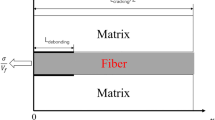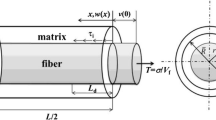The tensile behavior of cross-ply C/SiC ceramic-matrix composites (CMCs) at room temperature has been investigated. Under tensile loading, the damage evolution process was observed with an optical microscope. A micromechanical approach was developed to predict the tensile stress–strain curve, which considers the damage mechanisms of transverse multicracking, matrix multicracking, fiber/matrix interface debonding, and fiber fracture. The shear-lag model was used to describe the microstress field of the damaged composite. By combining the shear-lag model with different damage models, the tensile stress–strain curve of cross-ply CMCs corresponding to each damage stage was modeled. The predicted tensile stress–strain curves of cross-ply C/SiC composites agreed with experimental data.











Similar content being viewed by others
References
R. Naslain, “Design, preparation and properties of non-oxide CMCs for application in engines and nuclear reactors: an overview,” Compos. Sci. Technol., 64, No.2, 155-70 (2004).
D. B. Beyerle, S. M. Spearing, and A.G. Evans, “Damage mechanisms and the mechanical properties of a laminated 0/90 ceramic matrix composite,” J. of Am. Ceramic Soc., 75, No.12, 3321-30 (1992).
A. W. Pryce and P. A. Smith, Behavior of unidirectional and crossply ceramic matrix composites under quasi-static tensile loading,” J. Mater. Sci., 27, No.10, 2695-2704 (1992).
P. Karandikar and T. W. Chou, “Characterization and modeling of microcracking and elastic moduli changes in Nicalon/CAS composites,” Compos. Sci. Technol., 46, No.3, 253-263. (1993).
F. A. Opalski and S. Mall, “Tension-compression fatigue behavior of a silicon carbide calcium-aluminosilicate ceramic matrix composites,” J. of Reinforced Plastics and Composites, 13, No.5, 420-438 (1994).
S. W. Wang and A. Parvizi-Majidi, “Experimental characterization of the tensile behavior of Nicalon fiber-reinforced calcium aluminosilicate composites,” J. Mater. Sci., 27, No.20, 5483-5496 (1992).
L. P. Zwada, L. M. Butkus, and G. A. Hartman, “Tensile and fatigue behavior of silicon carbide fiber-reinforced aluminosilicate glass,” J. Am. Ceramic Soc., 74, No.11, 2851-2858 (1991).
G. N. Morscher, M. Singh, D. Kiser, M. Freedman, and R. Bhatt, “Modeling stress-dependent matrix cracking and stress-strain behavior in 2D woven SiC fiber reinforced CVI SiC composites,” Compos. Sci. Technol., 67, No.6, 1009-1017 (2007).
Y. Q. Wang, L. T. Zhang, and L. F. Cheng, “Comparison of tensile behaviors of carbon/ceramic composites with various fiber architectures,” Int. J. of Appl. Ceramic Technol., 10, No.2, 266-275 (2013).
L. B. Li and Y. D. Song, “An approach to estimate interface shear stress of ceramic matrix composites from hysteresis loops,” Appl. Compos. Mater., 17, No.3, 309-328 (2010).
L. B. Li, Y. D. Song, and Z. G. Sun, “Influence of fiber Poisson contraction on matrix cracking development of ceramic matrix composites,” J. of Aerospace Power, 23, No.12, 2196-2201 (2008). (in Chinese)
L. B. Li, Y. D. Song, and Z. G. Sun, “Uniaxial tensile behavior of unidirectional fiber reinforced ceramic matrix composites,” Acta Materiae Compositae Sinica, 25, No.4, 154-160 (2008). (in Chinese)
L. B. Li, Y. D. Song, and Z. G. Sun, “Uniaxial tensile behavior of cross-ply ceramic matrix composites,” Acta Materiae Compositae Sinica, 28, No.1, 179-186 (2011). (in Chinese)
L. B. Li, Y. D. Song, and Y. C. Sun, “Modeling tensile behavior of unidirectional C/SiC ceramic matrix composites,” Mech. Compos. Mater., 49, No.6, 659-672 (2014).
W. A. Curtin, “Stress-strain behavior of brittle matrix composites,” Comprehensive Composite materials, Elsevier Sci. Ltd. 4, 47-76 (2000).
J. Kim and P. K. Liaw, “Fracture behavior of ceramic matrix composites during monotonic and cyclic loadings,” Key Engineering Materials, 345-346, 649-652 (2007).
J. Kim and P. K. Liaw, “Tensile fracture behavior of Nicalon/SiC composites”, Metallurgical and Materials Transcations A, 38A, 2203-2213 (2007).
M. Steen, “Tensile mastercurve of ceramic matrix composites: significance and implications for modeling,” Mater. Sci. and Eng. A, 250, 241-248 (1998).
K. G. Dassios, D. G. Aggelis, E. Z. Kordatos, and T. E. Matikas, “Cyclic loading of a SiC-fiber reinforced ceramic matrix composite reveals damage mechanisms and thermal residual stress state,” Composites: Part A, 44, 105-116 (2013).
W. S. Kuo and T. W. Chou, “Multiple cracking of unidirectional and cross-ply ceramic matrix composites,” J. Am. Ceramic Soc., 78, No.3, 745-755 (1995).
K. W. Garrett and J. E. Bailey, “Multiple transverse fracture in 90o cross-ply laminates of a glass fiber-reinforced polyester,” J. Mater. Sci., 12, No.1, 157-168 (1977).
N. Laws and G. J. Dvorak, “Progressive transverse cracking in composite laminates,” J. Compos. Mater., 22, No.10, 900-916 (1988).
H. Fukunaga, T. W. Chou, P. W. M. Peters, and K. Schulte, “Probabilistic failure strength analysis of graphite/epoxy cross-ply laminates,” J. Compos. Mater., 18, No.4, 339-356 (1984).
I. M. Daniel and J. W. Lee, “The behavior of ceramic matrix fiber composites under longitudinal loading,” Compos. Sci. Technol., 46, No.2, 105-113 (1993).
J. Aveston, G. A. Cooper, and A. Kelly, “Single and multiple fracture,” Properties of Fiber Composites, Conf. on Proc., England: National Physical Laboratory, IPC. 15-26 (1971).
F. W. Zok and S. M. Spearing, “Matrix crack spacing in brittle matrix composites,” Acta Metallurgica et Materialia, 40, No.8, 2033-2043 (1992).
H. Zhu and Y. Weitsman, “The progression of failure mechanisms in unidirectional reinforced ceramic composites,” J. Mech. Phys. of Solids, 42, No.10, 1601-1632 (1994).
J. P. Solti, S. Mall, and D. D. Robertson, “Modeling damage in unidirectional ceramic-matrix composites,” Compos. Sci. Technol., 54, No.1, 55-66 (1995).
W. A. Curtin, “Multiple matrix cracking in brittle matrix composites,” Acta Metallurgica et Materialia, 41, No.5, 1369-1377 (1993).
C. H. Hsueh, “Crack-wake interface debonding criterion for fiber-reinforced ceramic composites,” Acta Materialia, 44, No.6, 2211-2216 (1996).
Y. C. Gao, Y. W. Mai, and B. Cotterell, “Fracture of fiber-reinforced materials”, Zeitschrift für Angewandte Mathematik und Physik (ZAMP), 39, No.4, 550-572 (1988).
Y. J. Sun and R. N. Singh, “The generation of multiple matrix cracking and fiber-matrix interfacial debonding in a glass composite,” Acta Materialia, 46, No.5, 1657-1667 (1998).
M. D. Thouless and A. G. Evans, “Effects of pull-out on the mechanical properties of ceramic matrix composites,” Acta Metallurgica, 36, No.3, 517-522 (1988).
H. C. Cao and M. D. Thouless, “Tensile tests of ceramic-matrix composites: theory and experiment,” J. Am. Ceramic Soc., 73, No.7, 2091-2094 (1990).
M. Sutcu, “Weibull statistics applied to fiber failure in ceramic composites and work of fracture,” Acta Metallurgica, 37, No. 2, 651-661 (1989).
H. R. Schwietert and P. S. Steif, “A theory for the ultimate strength of a brittle-matrix composite,” J. Mech. Phys. of Solids, 38, No.3, 325-343 (1990).
W. A. Curtin, “Theory of mechanical properties of ceramic-matrix composites,” J. Am. Ceramic Soc., 74, No.11, 2837-2845 (1991).
Y. Weitsman and H. Zhu, “Multi-fracture of ceramic composites,” J. Mech. Phys. of Solids, 41, No.2, 351-388 (1993).
F. Hild, J. M. Domergue, F. A. Leckie, and A. G. Evans, “Tensile and flexural ultimate strength of fiber-reinforced ceramic-matrix composites,” Int. J. of Solids and Structures, 31, No.7, 1035-1045 (1994).
W. A. Curtin, B. K. Ahn, and N. Takeda, “Modeling brittle and tough stress−strain behavior in unidirectional ceramic matrix composites,” Acta Materialia, 46, No.10, 3409-3420 (1998).
R. Paar, J.-L.Valles, and R. Danzer, “Influence of fiber properties on the mechanical behavior of unidirectionallyreinforced ceramic matrix composites,” Mater. Sci. and Eng.: A, 250, No. 2, 209-216 (1998).
K. Liao and K. L. Reifsnider, “A tensile strength model for unidirectional fiber-reinforced brittle matrix composite,” Int. J. of Fracture, 106, No. 2, 95-115 (2000).
S. J. Zhou and W. A. Curtin, “Failure of fiber composites: a lattice green function model,” Acta Metallurgica et Materialia, 43, No. 8, 3093-3104 (1995).
R. E. Dutton, N. J. Pagano, and R. Y. Kim, “Modeling the ultimate tensile strength of unidirectional glass-matrix composites,” J. Am. Ceramic Soc., 83, No. 1, 166-174 (2000).
Z. **a and W. A. Curtin, “Toughness-to-brittle transitions in ceramic-matrix composites with increasing interfacial shear stress,” Acta Materialia, 48, No. 20, 4879-4892 (2000).
N. Ramakrishnan and V. S. Arunachalam, “Effective elastic moduli of porous ceramic materials,” J. Am. Ceramic Soc., 76, No. 11, 2745-2752 (1993).
W. A. Curtin, “In situ fiber strengths in ceramic-matrix composites from fracture mirrors,” J. Am. Ceramic Soc., 77, No. 4, 1075-1078 (1994).
D. S. Beyerle, S. M. Spearing, F. W. Zok, and A. G. Evans, “Damage and failure in unidirectional ceramic matrix composites,” J. Am. Ceramic Soc., 75, No. 10, 2719-2725 (1992).
Acknowledgements
This work was sponsored by the Natural Science Foundation of Jiangsu Province (Grant No. BK20140813), the Postdoctoral Science Foundation of China (Grant No. 2012M511274), and the Introduction of Talents Scientific Research Foundation of Nan**g University of Aeronautics and Astronautics (Grant No. 56YAH12034). The authors also thank the anonymous reviewers and editors for their valuable comments.
Author information
Authors and Affiliations
Corresponding author
Additional information
Russian translation published in Mekhanika Kompozitnykh Materialov, Vol. 51, No. 3, pp. 505-530 , May-June, 2015.
Rights and permissions
About this article
Cite this article
Li, L.B., Song, Y.D. & Sun, Y.C. Modeling the Tensile Behavior of Cross-Ply C/SiC Ceramic-Matrix Composites. Mech Compos Mater 51, 359–376 (2015). https://doi.org/10.1007/s11029-015-9507-6
Received:
Revised:
Published:
Issue Date:
DOI: https://doi.org/10.1007/s11029-015-9507-6




